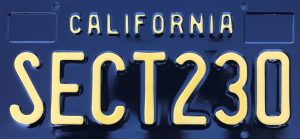Snapchat Isn’t Liable for Its Speed Filter (Even if Section 230 Doesn’t Apply)–Maynard v. Snapchat
Snapchat’s “speed filter” allows users to overlay their speed on their content. Unsurprisingly, some users viewed this as a challenge to capture a high speed on their speed filter; and in the course of doing so, tragedy could occur. In this case, McGee crashed into the Maynards’ car while engaged with the speed filter, causing significant personal injuries.
The Maynards sued Snapchat in addition to McGee. Snapchat defended on Section 230 grounds, which the lower court granted. The Georgia Appeals Court reversed, saying that Section 230 didn’t apply to the speed filter. This sent the case back to the lower court to review the case on the merits. On remand, the lower court ruled that Snapchat did not have a duty to prevent this injury. In a 2-1 decision, the Georgia Appeals Court affirms.
The court frames the issue: “the complaint alleges that the injury was caused by McGee’s conduct of mis-using the Speed Filter while driving at an excessive rate of speed. Thus, any liability on the part of Snapchat is predicated on McGee’s conduct.” But Snapchat doesn’t have general duties to the world; it only has duties to those in a “special relationship” with it. That does not include the Maynards:
Put simply, Georgia law does not impose a general duty to prevent people from committing torts while misusing a manufacturer’s product. Although manufacturers have “a duty to exercise reasonable care in manufacturing its products so as to make products that are reasonably safe for intended or foreseeable uses,” this duty does not extend to the intentional (not accidental) misuse of the product in a tortious way by a third party.
The Maynards responded that the speed filter encouraged risky behavior. The court replies that (1) Snapchat didn’t create any rewards or incentives for tortious behavior, and (2) the speed filter works in many circumstances beyond unsafe driving, such as on airplanes, so “it is up to the user to avoid dangerously misusing the application.” The court analogizes this to the lack of liability for cellphone apps, such as FaceTime, which some drivers misuse and cause injuries.
A dissenting judge argues that the Maynards alleged that Snapchat did not adopt a reasonable design and that led to foreseeable injuries, so they should get the chance to pursue this argument further.
 As it stands now, this case resembles other personal injury cases that have overcome a Section 230 defense only to fail on the merits, such as the cases involving failure-to-warn (e.g., the Internet Brands and Beckman v. Match cases). In those circumstances, no one benefits from permitting the plaintiff to plead around Section 230 only to lose on its prima facie elements; it just increases the costs of all involved to reach the inevitable outcome. Indeed, I do think Section 230 should apply to Snapchat’s speed filter, as a California court ruled in Lemmon v. Snap.
As it stands now, this case resembles other personal injury cases that have overcome a Section 230 defense only to fail on the merits, such as the cases involving failure-to-warn (e.g., the Internet Brands and Beckman v. Match cases). In those circumstances, no one benefits from permitting the plaintiff to plead around Section 230 only to lose on its prima facie elements; it just increases the costs of all involved to reach the inevitable outcome. Indeed, I do think Section 230 should apply to Snapchat’s speed filter, as a California court ruled in Lemmon v. Snap.
Case citation: Maynard v. Snapchat, Inc., 2020 WL 6375424 (Ga. Ct. App. Oct. 30, 2020)

Pingback: News of the Week; November 4, 2020 – Communications Law at Allard Hall()